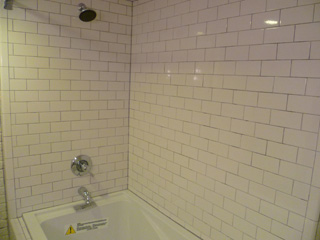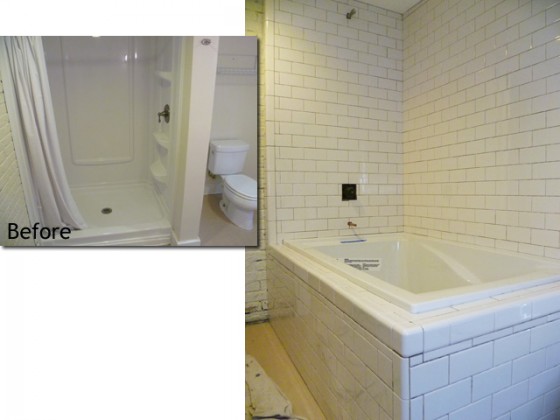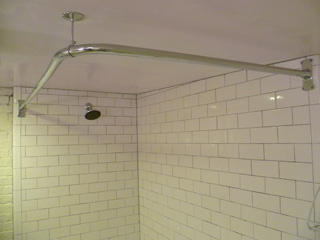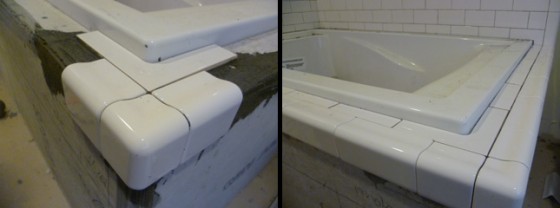 The large shower enclosure is now gone (see this post)and I’ve got the tub in place and everything hooked up. The next step is to install the tile. The homeowners wanted basic 3″ x 6″ white subway tile for all the walls. The nice thing about this tile is that there are a number of widely available trim pieces that match this tile. That would certainly be important for this tile installation.
The large shower enclosure is now gone (see this post)and I’ve got the tub in place and everything hooked up. The next step is to install the tile. The homeowners wanted basic 3″ x 6″ white subway tile for all the walls. The nice thing about this tile is that there are a number of widely available trim pieces that match this tile. That would certainly be important for this tile installation.
I took quite a bit of time to lay this project out. I had 2″ x 6″ bullnose edge pieces that would go around the perimeter and large corner pieces that would go around the tub. The grout lines needed to all match up and look correct- without having any tiny pieces that look awkward because of the layout.
I started with the wall tile, using my laser level to give me a line where the edge tiles would go so I could lay the field tiles to the ceiling. With the walls done, I next went to the tiles that would go on the platform. For this I wanted to use some large corner pieces that would give a nice rounded edge as well as leave a slight lip that might catch some of the water before it might run over onto the floor. Before I got out the thinset I set the pieces out and made sure the layout was correct and they would end up in the right place. After some tweaking this went down easily.
 Lastly, I tiled the ‘skirting’ around the front and side of the tub. I needed to start at the top edge and tile down. This is a little difficult because the tiles will want to slide downward, especially if your mortar is very ‘wet’. I used quite a bit of painter’s tape as I went a long to hold everything in place. I mentioned in my last post that the floors in this room were not level, but I had to frame the tub to be level. This meant that my bottom row of tiles would need to be cut at a slight angle to follow the floor. I tried to consider this from the beginning so I wouldn’t end up with any tiny slivers of tile, but instead mostly large pieces. It’s more difficult to notice a slope on a large tile than on a small one.
Lastly, I tiled the ‘skirting’ around the front and side of the tub. I needed to start at the top edge and tile down. This is a little difficult because the tiles will want to slide downward, especially if your mortar is very ‘wet’. I used quite a bit of painter’s tape as I went a long to hold everything in place. I mentioned in my last post that the floors in this room were not level, but I had to frame the tub to be level. This meant that my bottom row of tiles would need to be cut at a slight angle to follow the floor. I tried to consider this from the beginning so I wouldn’t end up with any tiny slivers of tile, but instead mostly large pieces. It’s more difficult to notice a slope on a large tile than on a small one.
 These homeowners wanted to keep the bathroom open, especially around the toilet, which is why we went with the design that omitted the wall on the back side of the tub. This is a little unusual, but not unheard of. The main difficulty is finding a shower rod for this application. You can find about anything online these days and that includes a corner shower rod. The rod has a small support in the corner to keep it stable once the heavy shower curtain is on it.
These homeowners wanted to keep the bathroom open, especially around the toilet, which is why we went with the design that omitted the wall on the back side of the tub. This is a little unusual, but not unheard of. The main difficulty is finding a shower rod for this application. You can find about anything online these days and that includes a corner shower rod. The rod has a small support in the corner to keep it stable once the heavy shower curtain is on it.
The grout for this project was a color called Delorean Grey. I’ve used it quite a bit with both white tiles and other shades. I’ve often wondered if it’s named after the car from Back To The Future. Hmmm…










